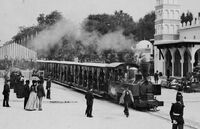
Machinery Hall at the Paris Exhibition, 1889
The 1889 Paris Exposition showcased many new architectural acheivements as well as a wide variety of technological advances. Among these were Edison's first motion picture, photographic advances, electrical and steam inventions, and iron works - typified by the Eiffel tower itself.
La Nature, Review of the sciences and their application in art and industry.
Series information: Volume: 1889: 17th year, second semester: n°835 à 861.
Creator: Tissandier, Gaston, chief editor; Parville, Henri de, director.
Publisher: Paris : Masson, 1889.
Language: French.
Physical description: [4]-444 p., 379 ill.,
Unique identifiers: CNAM 4° Ky 28.33,http://cnum.cnam.fr/SYN/4KY28.33.html.
Abstract: La Nature was a periodical published semi-anually in France, featuring advances in science and how the were presented and used in art, industry, and society. The second semester 1889 volume featured numerous advances that were unveiled or shown to the public at the 1889 Expo in Paris. Items that we might recognize or appreciate include: an explanation of the advances in electrical lighting (attended by noted scientists and inventors Thomson and Edison), advances in photography and telephony, etc.

Electric Lighting At The Paris Exhibition - The Oerlikon Works (3 parts),
Series information: Scientific American Supplement Volumes 643, 647, 664, 711, 717, 787, 794, 795, 799 and 803
Author: [ Albert Allis Hopkins, Alexander Russell Bond]
Publisher: Munn & Co., 1888-1891
Language: English
Unique identifiers: http://chestofbooks.com/crafts/scientific-american/sup6/Electric-Lighting-At-The-Paris-Exhibition-The-Oerlikon-Works-Part-2.html
Abstract: This site contains a technical description and schematic diagrams of electrical lighting technology used during the Paris exhibition.

Telephone exhibit
Musical Encounters at the 1889 Paris World's Fair
Abstract: The sixth chapter of this book - cited on the Music page - deals with the marvels of technology. But when we remember that recreating and interpreting the sonic landscape are major foci of the study, it is clear that Fauser, having dealt with retrospective and contemporary music at that fair, is deftly including material that forecasts future modes of listening, since these infant technologies would soon be able to capture sounds for posterity and transmit them around the world. In 1889 fairgoers tried out the telephone with transmissions from two bastions of French culture, the Opera and the Opera-Comique. (Watching people listening to operas on the telephone became a new form of entertainment.) Second, Thomas Edison's phonograph generated great excitement; the arrival of the inventor himself, feted as a symbol of modern meritocracy, created a virtual frenzy of interest. See: http://findarticles.com/p/articles/mi_hb6657/is_2_63/ai_n29310570/pg_2/
A Franco-American Battle of Beams: Electricity and the Selling of Modernity
Series information: Journal of Design History, Summer 2005; 18: pp. 147 - 166.
Creator: Cordulack, Shelley Wood
Publisher: Oxford University Press, 2005.
Unique identifier: http://www.jstor.org/stable/3105107 , http://jdh.oxfordjournals.org/cgi/content/abstract/18/2/147
Abstract: In spite of the American lead in the application of electricity,it was the French graphic artists who put forward the new sourceof light in such a way that won for Paris not only the rightto retain its title of ‘la ville lumière,’but also to sell its modernity. How this was accomplished duringthe late nineteenth century against the background of both Americanand French nationalism—through the advanced representationof electricity in Paris-based graphic images of the Statue ofLiberty and the Eiffel Tower in particular—is the subjectof this study, which pushes the influence of electric lighton art, specifically on French graphic art, back to the 1880s–1890s.

The Galerie des Machines of the 1889 Paris World's Fair
Series information: Part of "Engines of Ingenuity," a radio program.
Creator: Lienhard, John
Publisher: KUHF-FM Houston
Physical description: Audio reproduction of a radio broadcast.
Unique identifier: http://www.uh.edu/engines/epi300.htm , audio file at http://www.kuhf.org/programaudio/engines/eng300_64k.m3u
Note: Another citation is given at the bottom of the piece as follows: "John W. Stamper Technology and Culture, Vol. 30, No. 2, Special Issue: Essays in Honor of Carl W. Condit (Apr., 1989), pp. 330-353, The Johns Hopkins University Press on behalf of the Society for the History of Technology"
thumb|300px|rightThe Very First Motion Picture (1889)
Creator: Decker, Kerry.
Publisher: YouTube, 2008.
Language: English
Physical description: YouTube video, 3:31 (length)
Unique identifier: http://www.youtube.com/watch?v=dDmAxdLvdQ4&feature=related
Abstract: This video shows the first experimental movie that Thomas Edison made in 1889. In 1878, British photographer Eadweard Muybridge made a series of still photographs of a horse that when viewed in sequence, appeared to be galloping. Edison felt this was too cumbersome for practical use and soon developed a system for "motion" pictures, based on his wax cylinder for phonographs. Thus you will see the two short sequences still in existance of the very first American motion picture from 1889.

Le "chemin de fer portatif" Decauville
Series information: One of a group of articles related to the transport of stone
Creator: not given
Publisher: ruedeslumieres.morkitu.org, 2005-2009.
Language: French
Physical description: On-line article
Unique identifier: http://ruedeslumieres.morkitu.org/telecharger/transport_pierre/Transport%20pierre%20%20III%20-%20Le%20chemin%20de%20fer%20portatif%20Decauville.pdf
Abstract: The article explains how Paul Decauville invented the portable narrow guage railway, originally to transport an abundant beet harvest before it spoiled in the fields. About 3 km of Decauville's narrow guage railway would be installed at the expositions universelled to transport visitors to five different stations and through two tunnels.
The Education of Henry Adams
Series information: Chapter 25 of the book, entitled "The Dynamo and the Virgin"
Creator: Adams, Henry
Publisher: Houghton Mifflin, Boston, 1918.
Language: English
Physical description: On-line article
Unique identifier: 1-58734-000-3,http://www.bartleby.com/159/25.html
Abstract: This chapter of Adams' book chronicles Adams' experience at the Fair in 1889 and how the inventions on display in the Galerie des Machines captivated him.